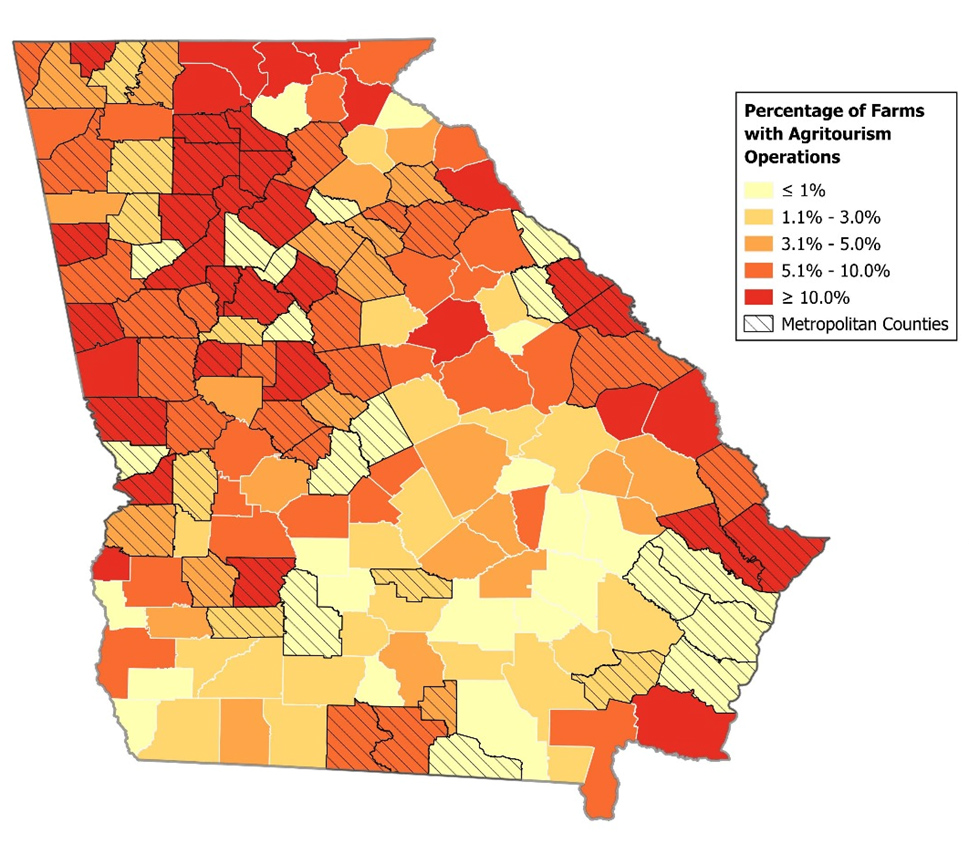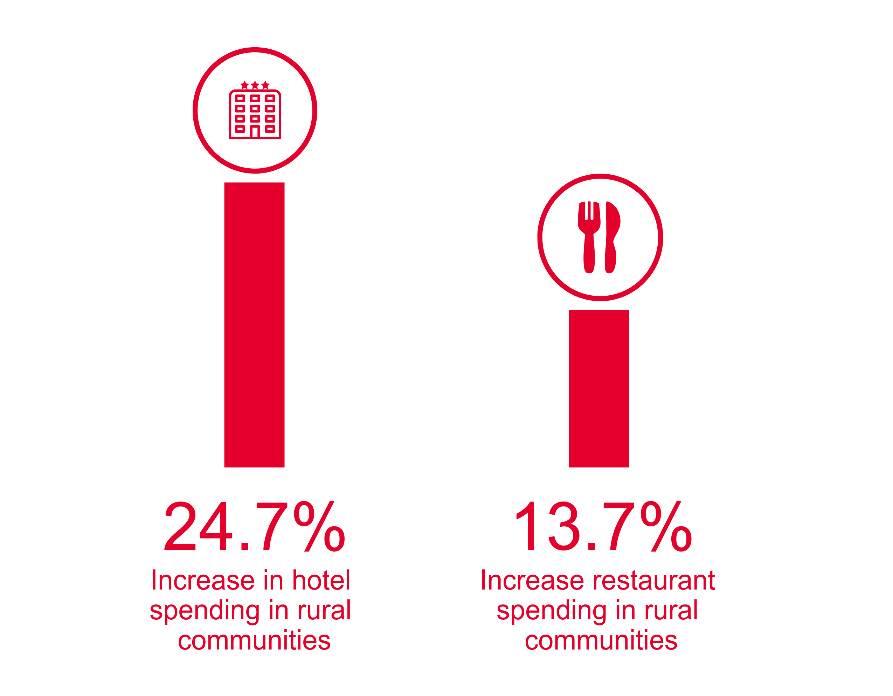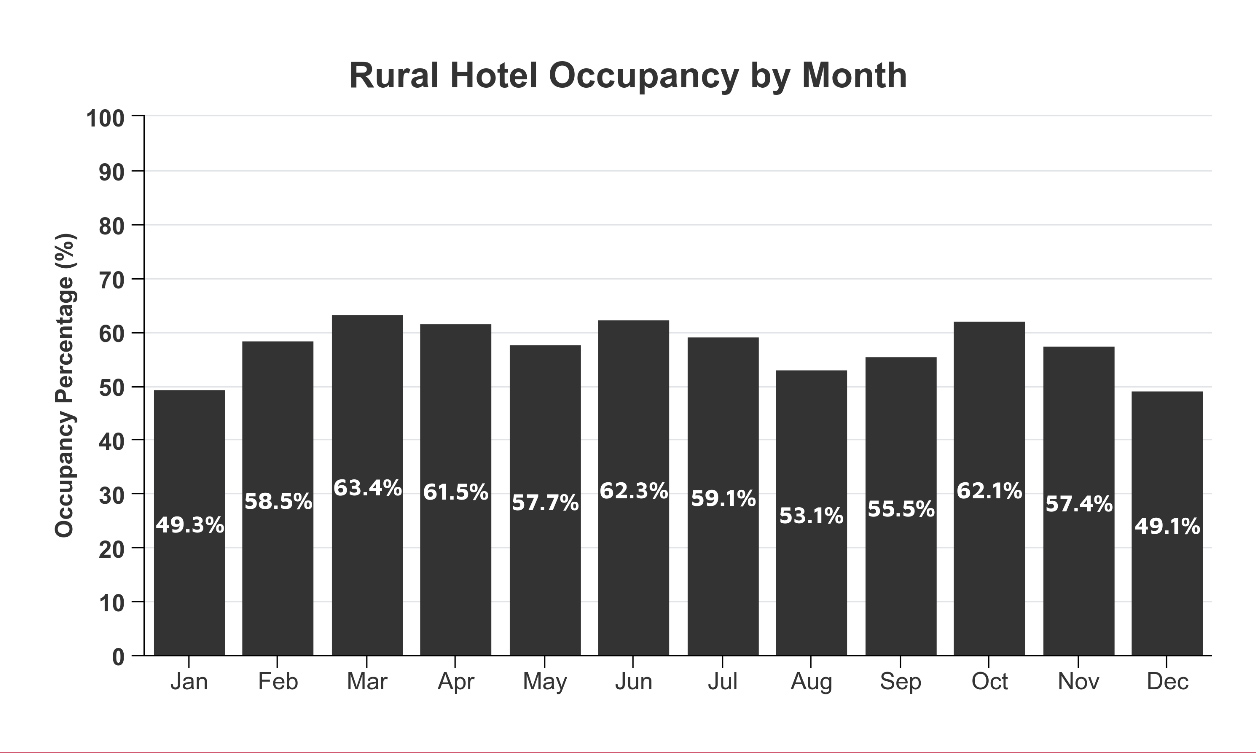Main Takeaways
- Total gross demand for accommodations in Georgia’s rural counties increased 24.7% in 2022.
- Total gross demand for food in Georgia’s rural counties increased 13.7% in 2022.
- Visitation to state park and outdoor recreation areas increased 1% in 2022.
- In 2023, pick-your-own farms and wineries/distilleries/breweries comprised almost 20% of the state’s agritourism attractions.
- 2023 hotel demand will end with modest growth for both the Georgia rural and urban counties.
- Total number of trips among U.S. travel will grow 4.3% in 2024.
According to the U.S. Department of Agriculture, agritourism is an enterprise that combines agricultural production and/or processing with tourism and hospitality activities. It aims to attract visitors to farms, ranches, or agricultural entities. Common examples of agritourism include visiting pick-your-own fruit or vegetable farms, pumpkin patches, corn mazes, petting zoos, wineries, Christmas tree farms, farm stays, and many others.
Agritourism benefits multiple stakeholders, including farmers, visitors, and local communities. It provides farmers with various opportunities to diversify their revenue streams and build relationships with consumers. It grants valuable opportunities to both educate and entertain individuals and families. Additionally, it contributes to the revitalization of local communities economically, socially, and culturally. As a result, the popularity of agritourism has grown appreciably around the world.
The Current and Future State of Georgia Tourism
Demand increased in 2022 for Georgia agritourism, visitor spending in both rural and urban communities, gross final demand, lodging, and state park visitation. However, much of the growth still lagged behind the record pre-pandemic tourism indicators.
The outlook for 2024 continues to show signs of improvement above 2022. Year-to-date hotel occupancies for 2023 show a 1% U.S. increase and a 0.2% Georgia increase from 2022. According to Smith Travel Research, 2024 U.S. occupancy is expected to be 1% above 2023, and they consider the post-pandemic travel recovery in the United States complete. STR also predicts that the U.S. average daily rate (ADR) will grow 3% over 2023 figures. The U.S. Travel Association predicts that 2023 will end with a 3.7% increase in total number of trips above 2022.
The 2023 increase is mostly because of the continued rebound in business travel, which has a stronger impact on urban markets. They also predict that once all the 2023 numbers are in, travel demand by the end of that year will have hit pre-pandemic demand levels. For 2024, a 4.3% increase in the total number of trips is projected by U.S. Travel with over 1.9 billion leisure travelers and 371 million business travelers. Most of the 2024 growth will be attributed to increased business travel.
According to the St. Louis Fed, personal consumption of Georgia accommodations and food services has been increasing since 2020. While state hotel occupancies, revenue, and hotel rates were on the rise for 2023, the growth is expected to slow in 2024. Though there are mixed predictions about inflationary pressures on consumer spending, travel consumption is predicted to continue to grow into 2024 asserting that consumers are willing to spend less on nonessential goods but plan to continue to spend more on travel.
Georgia’s tourism industry is fortunate to have a diverse destination portfolio where both leisure and business travel destinations can be found throughout the state. With the national forecast expecting continued growth in the leisure and business travel markets, both Georgia rural and urban counties are expected to grow in total tourist demand at a modest to moderate rate like overall U.S. trends.
Agritourism’s Historical Growth
The USDA Census of Agriculture reports an agritourism analysis every 5 years; the next report will be released in February 2024. Based on the most recent agricultural census data, farm-based agritourism income experienced a threefold increase between 2002 and 2017 and was 5.6% of the total U.S. farm-related earnings in 2017. When adjusted for inflation, the revenue generated by agritourism increased from $704 million in 2012 to nearly $950 million in 2017.
The increasing popularity of agritourism has also been observed in the state of Georgia. In 2017, among the 13,216 farms in Georgia, 736 (5.57%) reported that they offered agritourism products and services. These farms collectively earned $28 million in revenue that year, which accounted for an 8% increase compared to their revenue from agritourism in 2012 ($26 million). Out of the 159 counties in Georgia, four counties surpassed $1 million in revenue from agritourism: Floyd, Hall, Gilmer, and Cherokee.
National reports suggest that farms and ranches in rural regions are more inclined to embrace agritourism, whereas those located in urban or densely populated areas generally tend to generate higher revenue from it. As for the state of Georgia, the percentage of farms that have adopted agritourism in metropolitan counties was 7.55%, compared to nonmetropolitan counties at 4.43%. Figure 1 presents additional information on the percentage of farms with agritourism operations in Georgia.

While the most recent agritourism census data wasn’t available at the time of this analysis, the University of Georgia Center for Agribusiness and Economic Development Farm Gate Value report shows an increase in agritourism revenues for all Georgia counties. Agritourism-related revenues increased 28% from an estimated $989 million in 2018 to an estimated $1.08 billion in 2021.
As of 2023, the Georgia Department of Agriculture lists over 430 registered agritourism attractions within its database. Gilmer, Fulton, Hall, Henry, and White counties each have 10 or more registered agritourism attractions. Of the various types of agritourism attractions, the two largest categories are pick-your-own farms (42 locations) and wineries/distilleries/breweries (40 locations), comprising 9.6% and 9.2% of all agritourism attractions, respectively. Almost 9% of the state’s agritourism attractions contain a restaurant and/or other food service options. Over 43% of the attractions also offer a retail outlet in the form of a bakery, farmers market, and/or specialty store.
Recent Growth in Rural Tourism Reflects Increasing Demand for Agritourism
Agritourism brings visitors to local farms and attractions while also introducing tourists to Georgia’s rural communities. It is closely affiliated with nature based and outdoor recreation activities. This niche tourism enhances the overall experiences for potential visitors, which can increase expenditures and overall length of stay. Consequently, the economic success of Georgia agritourism and the larger tourism industry are inextricably linked.
According to the 2022 Economic Impact of Tourism in Georgia report, visitor spending in Georgia increased by 14.9% to approximately $32.7 billion in 2022 from $28.5 billion in 2021. Georgia is a very diversified tourism state offering visitors experiences that range from coastal landscapes to mountain destinations, and from rural retreats to urban getaways. Consequently, the state’s tourism economy will impact rural and urban communities differently. Eighty-five Georgia counties can be categorized as rural while 74 counties are considered urban. For 2022, visitor spending was $3.9 billion in the state’s rural counties and $28.7 billion in urban counties. The 2022 average state and local tax savings was $399.70 for rural households and $391.20 for urban. Both visitor spending and state and local tax collections have increased above 2021 levels.
Increase in Visitor Spending Leads to Increased Gross Final Demand for Accommodations and Food Services
Where destinations inspire tourists to travel, hospitality services are where the business of travel occurs. According to the 2022 Economic Impact of Tourism in Georgia report, approximately 45% of visitor spending occurs within the accommodations and food services sector; it is the largest category of visitor spending and leads to increased gross final demand. Gross final demand is a measure of the total spending demand for final goods and services.
For the state, gross final demand for the lodging sector increased 24% from $4.3 billion in 2021 to $5.3 billion in 2022. For 2022, rural community final demand for accommodations was $425.5 million, a 24.7% increase above the $343.9 million in 2021. This has been the highest final-demand year since the pandemic, but gross spending for lodging has not yet fully returned to its pre-pandemic levels. For urban counties, spending increased 24.3%, from $3.2 billion in 2021 to $4 billion in 2022.
For rural communities, the food services sector increased 13.7%, reaching $3.1 billion in 2022 from $2.7 billion in 2021. Demand for food services in urban counties also increased 15.3% in 2022 to $25.5 billion ($22.1 billion in 2021). In 2022, there were double-digit increases in final demand for both the rural and urban counties in the accommodations and food services sector. Figure 2 represents the rural spending increase from 2021 to 2022 for this sector.

In 2022 there was a 24.7% increase in hotel spending and a 13.7% increase in restaurant spending in Georgia’s rural counties.
Rural and Urban Hotel Occupancies and Rates Also Increased in 2022
Hotel occupancy and ADR are key metrics that reflect the economic vitality of the accommodations industry. Occupancy is an indication of room demand for destinations, while ADR is the average room rate paid by guests. For 2022, average U.S. hotel occupancy was 63.8%, a 10.2% increase above the 2021 average (57.9%). For Georgia, 2022 occupancy was 62.6%, a 5.5% increase above 2021 levels. The 2022 U.S. ADR was $149.22 while the Georgia ADR was $118.24; both showed increases above the 2021 ADR.

For rural communities, the 2022 57.4% occupancy rate was similar to the previous year’s 57.3%. March, June, and October were the months with the highest 2022 occupancy in rural areas (Figure 3). The rural county ADR was $104.09, a 10.8% increase above the 2021 rate of $93.96. For urban counties, occupancy increased 6% to 63.5% in 2022 (from 59.9% in 2021), and ADR increased 16.8% to $119.42 from the previous year’s rate of $102.25. In 2022, urban areas had the highest occupancies during April, June, and July. The growth in hotel occupancies and ADR throughout Georgia and in both rural and urban areas mirrors the increase in visitor spending and gross final demand for accommodations and food services. However, rate growth outpaced occupancies for both rural and urban areas, showing that consumer spending on lodging continues to increase with little impact on overall room demand for both markets.
Demand for Georgia State Parks and Outdoor Recreation Increases for 2022
There are 58 locations throughout Georgia managed by the Georgia Department of Natural Resources. An additional six locations are managed by the Rocky Mountain Public Fishing Area and the North Georgia Mountain Authority. Natural resources and outdoor recreation are vital to tourism and are often established in rural areas. Thirty-three state parks and outdoor recreation locations can be found in rural communities, while 34 are in urban counties. Overall visitation to the state’s recreation areas increased 1% to 14,100 from the previous year’s approximately 14,000 visitors, which also coincides with growth trends previously mentioned.
Status and Revision History
In Review on Jan 19, 2024
Published on Jan 22, 2024


























































